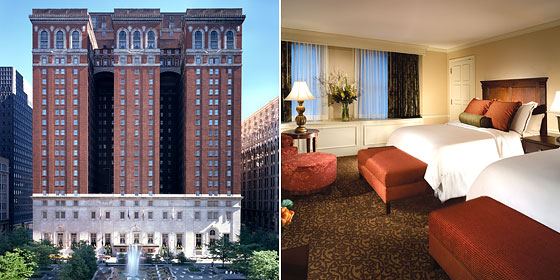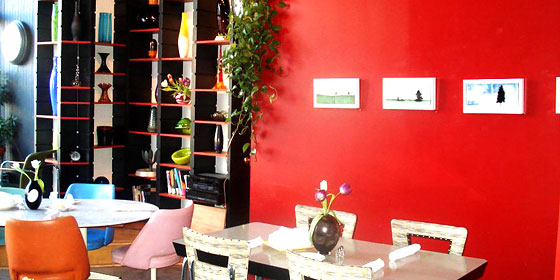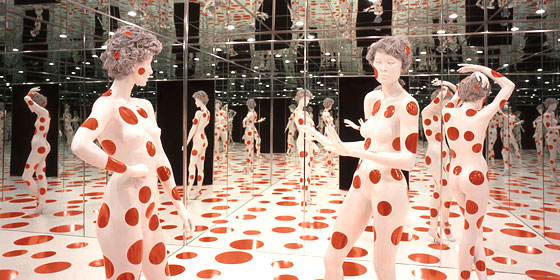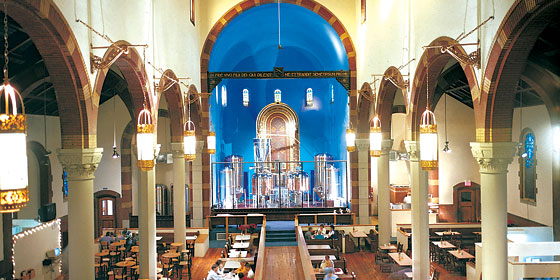1. Where to Stay

Victorian B&Bs can be stuffy, but the Parador Inn’s ($150) Caribbean theme enlivens an 1870s mansion with tropical tones and reggae music throughout the first floor. Each room is different, but all eight are equally priced and sizable (the smallest is 324 square feet), with high ceilings and working fireplaces. Seven rooms are in the mansion; if you seek privacy or are staying longer, ask for the detached carriage house.
Architecture aficionados stay downtown at the Omni William Penn Hotel (from $152 if you book three weeks in advance), now being restored to its original opulence. The ornate lobby (chandeliers, gilded mirrors) leads to 596 guest rooms and a 24-hour fitness center. Ask for one of the updated floors to get the new furnishings, pillow-top mattresses, and flat-screens.
The Priory (from $140), once a nineteenth-century home to Benedictine monks, is now a 25-room hotel just an eight-minute walk from the Andy Warhol Museum. There’s a highway nearby, so ask for a room facing the inner courtyard, where a gurgling fountain serves as white noise.
2. Where to Eat

There’s usually a line for brunch at Coca Café, a colorful eatery–cum–gallery in the once blighted, now bohemian, design district of Lawrenceville. Leave your number with the hostess and stroll through the indie boutiques along Butler Street while you wait for a table.
Break for lunch at The Quiet Storm, a vegetarian restaurant and coffeehouse teetering on the edge of a ten-block area dotted with galleries and theaters. There’s local artwork, a “Monster Bash” pinball machine, and a dish called the Maelstrom: a quesadilla stuffed with chickpeas, mushrooms, spinach, and homemade cucumber yogurt.
Tram’s Kitchen (4050 Penn Avenue; 412-682-2688) has bad lacquered art, but the Vietnamese menu and BYO-friendliness more than compensate. The owner-waiter juggles a packed restaurant with little patience, so don’t be surprised if your check arrives before your appetizer. Cash only.
3. What to Do

Take a solitary morning walk through James Turrell’s disorienting light sculptures at the Mattress Factory. The four-story Stearns & Foster warehouse on the North Side became an installation space in 1977. Thaddeus Mosley’s sinewy wooden sculptures are on display upstairs through August 2, 2009.
Brew House, a live-work community arts center on the South Side, is open to visitors on Saturday afternoons from noon to 6 p.m. During special events, the roof of the former Duqesne Brewery is open for a clear view of the city and the occasional barbecue. If you’re comfortable around naked strangers, there’s a figure-drawing-and-brunch session on the second Sunday of the month.
Take a twenty-minute cab ride out to Braddock , a crumbling mill town with a Catholic school turned artist colony. At Unsmoke Systems, the auditorium is a gallery, classrooms are studios, and stairwells and hallways serve as canvases. The building’s exterior was reimagined by New York street artist Swoon, who wheatpasted a life-size print of three Palestinian boys near a side door.
Visual artist Tim Kaulen welded together the thirteen-foot-tall steel heron that sits in the lobby of the Pittsburgh Children’s Museum. His sculptural ode to the city’s blue-collar past is at the abandoned LTV Steel (4650 Second Avenue) plant where he and fellow artists, known as the Industrial Arts Co-Op, are building eighteen-foot figures made from recycled beams. Send a friendly e-mail prior to your visit to ensure easy access.
4. Insider’s Tip
The Pittsburgh accent and unique turns of phrase are derived from early Scotch-Irish immigrants and still used by older residents, known as “yinzers.” Study Pittsburghese before you go; if someone tells you that “Kennywood’s open,” check your fly.
5. Oddball Day

The collapse of the city’s steel industry in the eighties incited a mass exodus that cut the population in half. Left behind were dozens of churches, several of which are now secular structures. Start your pilgrimage with drinks at Church Brew Works, a microbrewery formerly known as St. John the Baptist Church. The pews, wood floor, and stained-glass windows are original, installed in 1903. Sit by the altar, near the copper tanks, or take a seat outside in the Hops Garden. The beer menu reflects a religious past—there’s Celestial Gold, Pious Monk Dunkel, and Pipe Organ Pale Ale. Balance your beer with pierogies, a starchy Pittsburgh staple. Ask the bartender for the number for a cab service—hailing one is nearly impossible—and cross the Allegheny River during a six-minute ride to Millvale. The redesigned Mr. Smalls Skate Park has a street course and ramps and draws amateurs and pros alike. Three blocks away is Mr. Smalls Theatre, an eighteenth-century church reborn as a performance space, rocker hostel, and recording studio. Bands like the Meat Puppets, Camera Obscura, and Jenny Lewis (along with a healthy dose of metal acts) will all play there this summer.
6. Links
Navigate Pittsburgh’s diverse neighborhoods with the detailed guides on e-zine Pop City.
John Morris was the artistic director of the Digging Pitt Gallery before it closed; now he obsesses about “art, chaos and all that” on the Digging Pitt blog.
Founded at the University of Pittsburgh, the Original profiles local talents like mash-up star Girl Talk.